A Space Shuttle flight at the Kennedy Space Center by Phil Konstantin
For most of my life, I have been a space travel enthusiast. As a youngster, I kept scrapbooks
of all of the spaceflights. Even though I was fairly young, I remember
the Mercury flights. My interest increased as I got older. Like most people alive
at the time, I know exactly where I was when Apollo 11 landed on the moon. My
interest in the space program eventually led to me working at NASA in Houston,
during Apollo 16, 17 & all of the Skylab missions.
For most of that time, I helped to run the computers in the Real Time Computer Complex
(RTCC). These were the computers
that ran the flights. I was 19 when I started working there. In fact, I was one of
the youngest people there for a while. I was not that important, being just a lowly computer operator.
In fact, I mostly managed the system's peripherial equipment such as printers and disc packs, but I
would occasionally get to rub elbows with some of the bigwigs because I had to go
into different parts of the operation center to do some minor activities with remote
computer operations.

Real Time Computer Complex - 1. IBM photo
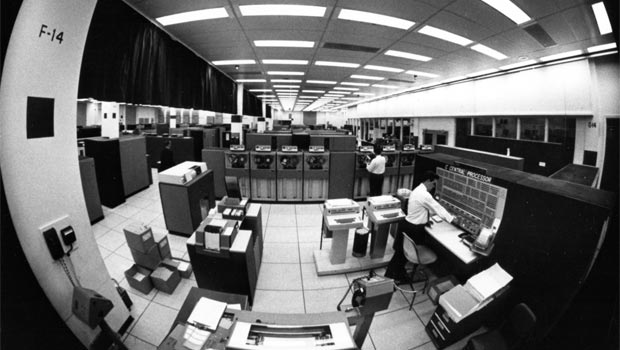
Real Time Computer Complex - 2. IBM photo



My IDs when I worked at NASA. The photo was taken around 1972.
The RTCC was directly below the Mission Operations Control Room (MOCR) which you have seen
on TV & in the movies. The computers I helped to run were 5 IBM 360, model 75J. These
computers had a total storage capacity of about 1 megabyte. According to an IBM website:
"the Model 75 had a monthly rental range of $50,000 to $80,000, and a purchase price
range of $2.2 million to $3.5 million."
I often worked the overnight shift. Whenever there was a mission on,
I would spend my lunch time in the MOCR's visitor viewing room. So, I saw lots of engineers,
flight directors, and the occasional astronaut. Technically, I had clearance to be in the
viewing room, but I really did not have permission to be there. So, whenever a splashdown
would come up, I'd go in early and sit in the back. I'd stay there until someone asked me
to leave. I cannot remember which mission it was, but Alan Shepard sat next to me for one
splashdown. It was probably for one of the Skylab missions. I got there early for another
splashdown. There were only a couple of people
on the MOCR floor because it was the last break before splashdown. Chris Kraft (the head
guy at the Johnson Space Center) was one of the few people on the MOCR floor. He kept
staring at me. He was not the kind of guy you wanted mad at you. I didn't want to leave,
because that might attract some attention. After watching me for about 10 minutes, he
got on the phone. Another 10 minutes later, a NASA PR guy came in and said he was happy
I decided to watch the splashdown & that they did not think I would be coming. I was
confused. But, I smiled and said I was happy to be there. Another PR guy came in a few
minutes later & asked me who I was. I told him, and he smiled. They all thought I was
Chris Kraft's son who was in college in the northern US. Chris could not figure out why
his son had not come down on the floor to say hello. After my identity was established,
they nicely told me that all of the seats were taken, and I left.

View of the MOCR from the viewing room where I spent many a lunch hour.
That is Flight Director Gene Kranz in the bottom center of this NASA photo
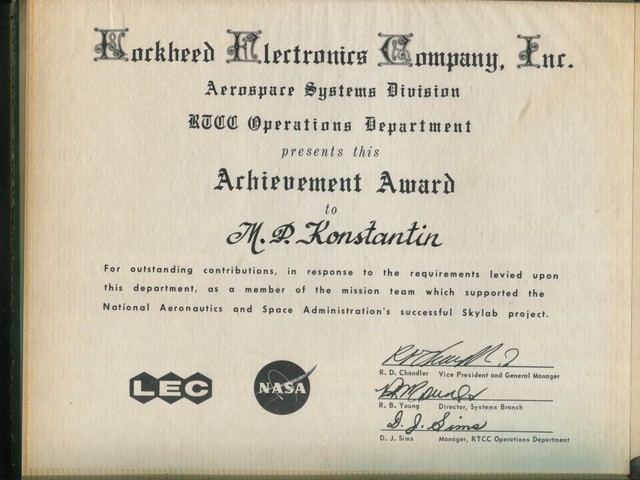
A copy of the Commendation I received for my work on the Skylab Missions.
Over the years after leaving NASA, I have met several astronauts,
interviewed them, and wrote magazine and newspaper articles about space flights. A
few years ago, I saw one of the shuttle flights land at Edwards Air Force base in
California. See the shaky video below.
The one thing missing in all of this was that I had never seen a space
mission take off. Finally, this was to change.
I took all of the pictures on
this page except for the ones with me in them, or if noted otherwise.
Space Shuttle mission STS-100 was scheduled to liftoff around 2:40pm (1440) on April 19, 2001. I arrived at the Kennedy Space Center a little after 8am and went to the Press Center. The Press Center is near the Vehicle Assembly Building (VAB). This is where the shuttle is assembled. At one time, the VAB was the largest, air conditioned, open building in the world.
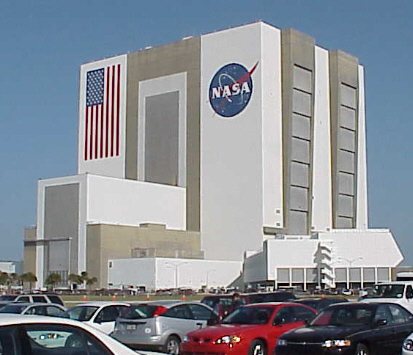
Vehicle Assembly Building
When the shuttle has been assembled it is transported to the appropriate launch pad. In this case, it was Pad 39A.

Pad 39A. The large white pole on the top is a lightning rod.
This picture was taken after the shuttle took off.
The shuttle was moved to Pad 39A by means of the "crawler." At full speed, it moves at about 1 mile per hour when it is carrying the shuttle. It zips along at a speedy 2 mph without any cargo.

The empty crawler approaching Pad 39A.
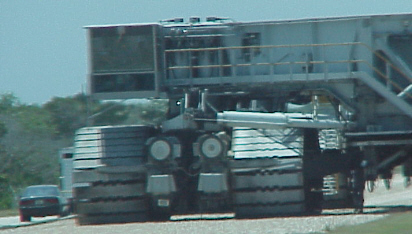
Detailed look at the crawler. Looking at the car on the left gives you an idea of its size.

Another detailed look at the crawler.

The shuttle as it approaches the launch pad. NASA photo
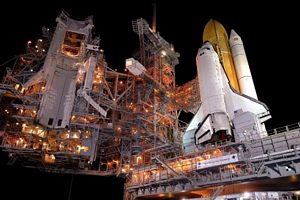
A night look at the shuttle at the pad. NASA photo
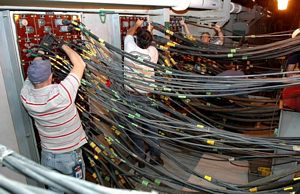
Detailed look at some of the wiring which connects the shuttle to the tower. NASA photo
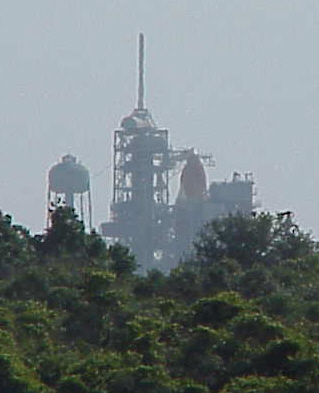
The shuttle on the pad (taken from the Press area).
At approximately 10:55am, the shuttle astronauts left their training facility to be driven over to the shuttle.
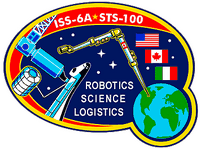

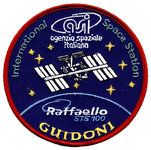
These are the various patches which the astronauts wore for this mission.

Astronauts entering their ground transportation van.
The man with the goatee is Umberto Guidoni. Immediately behind him is Kent Rominger. Facing you with his arm up waving is Scott Parazynski. The head next to Scott's is John L. Phillips. Next to him is Chris Hadfield. Entering the van are Yuri Lonchakov and Jeffrey Ashby
Click here to see a larger copy of this picture.
After the astronauts got in their van, I went back to the Press Center. Often on TV, and even in some movies such as Armageddon, you have seen a big countdown clock with the space craft in the distance. This clock is in front of the Press Center viewing area. It is approximately three miles from the launch pad.
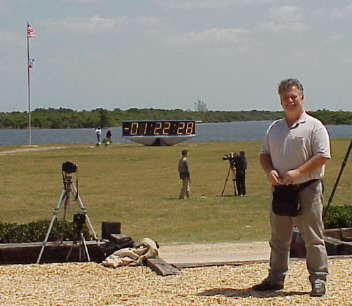
Me next to the countdown clock. The Shuttle is in the distance just above and to the right of the 8 on the clock.
Click here to see a larger copy of this picture.
Right on time, the Shuttle took off. NASA pumps thousands of gallons of water into the area under the launch pad. This keeps the area cooler and it helps to dampen the roar of the rockets. When the flames of the rockets hit this water, it generates steam. This steam forms much of the clouds you see at a launch.
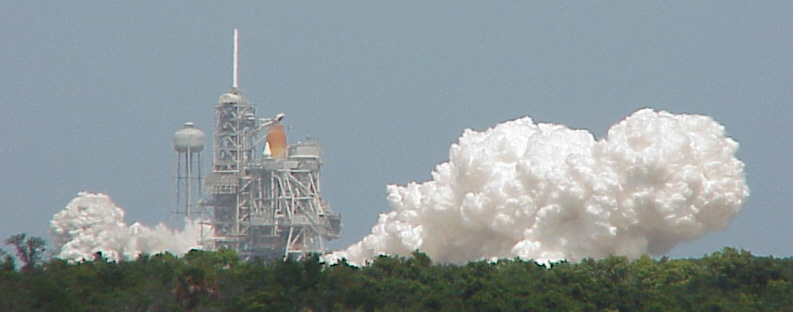
Seconds after the shuttle's engines have started.
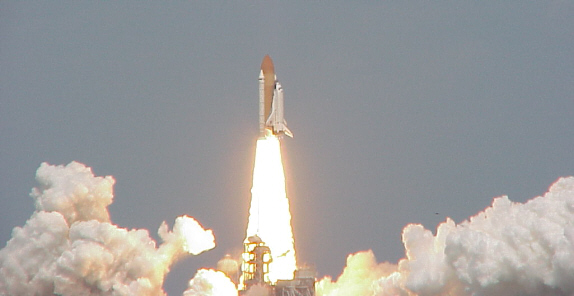
The Shuttle has cleared the tower.
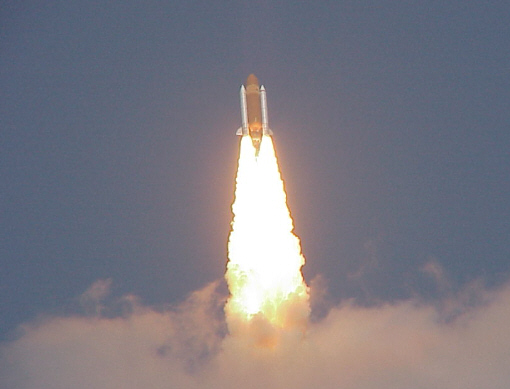
The Shuttle has rolled over.
Click here to see a larger copy of these picture.
I was surprised by how fast the shuttle lifted off. Once it cleared the tower, it rapidly picked up speed. The flames were very bright. I had to squint to look at them directly. The roar of the engines was very loud, and you could feel the vibration and heat at the press viewing area. We quickly lost sight of the shuttle because of some clouds overhead.

The smoke trail from the shuttle lasted for some time.
Official NASA photos of the crew
 |
 |
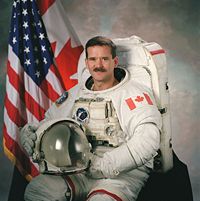 |
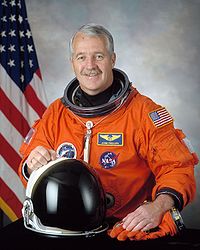
|
| Kent Rominger | Jeffrey Ashby | Chris Hadfield | John L. Phillips |
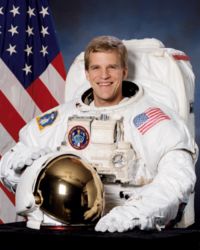
| 
| 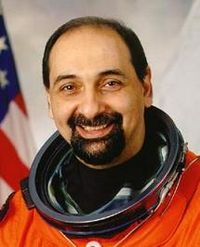
|
| Scott Parazynski | Yuri Lonchakov | Umberto Guidoni |
Click here to see an official, 20 minute NASA video about the mission
Before the Mercury Program, the military launched missles from Cape Canaveral.
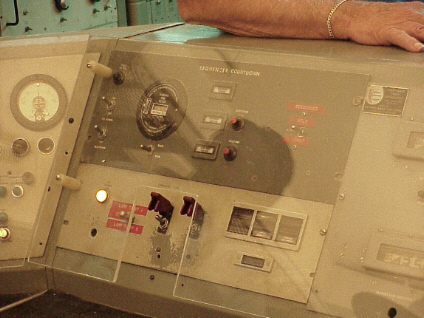
This is the control panel which was used to launch those early flights.
Before humans went into space, chimps were sent up. There were quite a few of them. They were trained to perform some basic tasks while in the capsules.
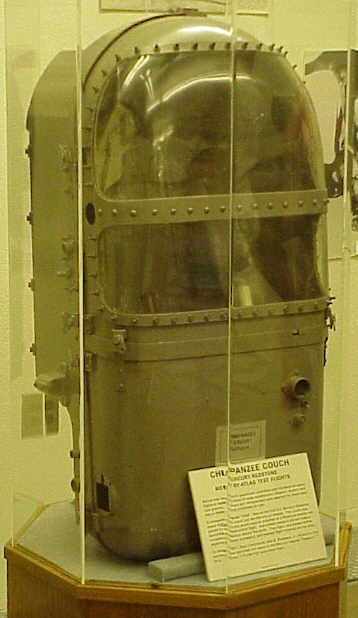
This is the capsule the chimps used.
The Mercury flights lifted off from the same area. By this time there were more complex equipment being used.
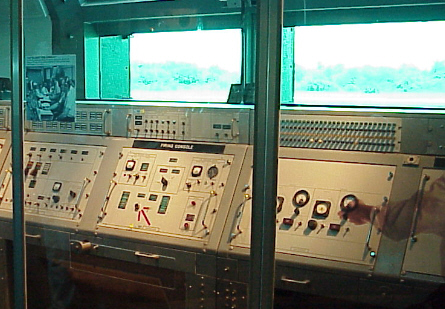
This is the Mercury Control Room. Note the red arrow. It points to the button which was pushed to launch the rocket.
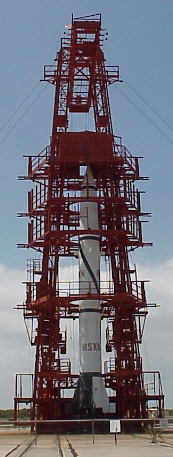
The gantry used to support the rockets.

This is a special monument dedicated to the "Original 7" Mercury astronauts.
After the Mercury missions came the Gemini flights. Gemini was designed to practice manuvering in Earth orbit, and docking two space craft. These flights carried two astronauts. Wally Schirra once told me the Gemini spacecraft was his favorite. It reminded him of a sports car.

A sign listing the different Gemini flights.
Then after Gemini, came Apollo. The goal of Apollo was to land people on the moon, and to safely return them. Apollo 1 was to be the first test of the new three person capsule. As with all of the other missions, thousands of hours of testing and training took place before a flight. Unfortunately, some sort of spark ignited the oxygen atmosphere inside of the Apollo 1 capsule during one of these tests. NASA investigated what happened and made hundreds of changes to the space craft.

The Apollo 1 launch pad. It is labled "Abandoned In Place."

The plaque commemorating the Apollo 1 astronauts.
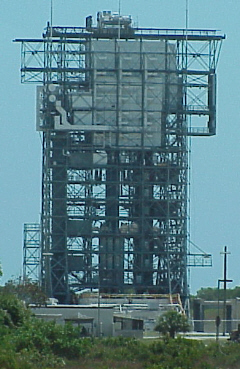
One of the Delta rockets on a nearby launch pad (LC 17).
I have met four of the "Original 7" astronauts. I first met Wally Schirra in San Diego at the Aerospace Museum. I sat next to Alan Shepard in the Mission Control Viewing Roon during the splashdown of one of the space missions. I passed Deke Slayton once in the hallway. I met Scott Carpenter at the Rueben Fleet Science Center in San Diego in 2003. I have also met several Gemini, Apollo, and Shuttle astronauts. See their photos on my Close Encounters With American Astronauts page. The link is below.
News report I produced about interviews I had with several astronauts in 2009.
Click here to see a video of a news story on Apollo 11's 40th anniversary.
Click here to see a video of an interview of Apollo 11's 40th anniversary with Buzz Aldrin, Charlie Duke and Alan Bean
Click here to see a magazine article I wrote about Wally Schirra in 1993.
Click here to see photos of my Robbins Medallions collection
Click here to go to my SPACE page
Click here to go to my Close Encounters With American Astronauts page
"Additional NASA photos I took in 1994 & 2001.
My visit to Florida for a shuttle launch:
Total Solar Eclipse magazine article
NASA Stories magazine article
US Space Program: Rising to New Heights magazine article
Voyager Mission magazine article
Here are some helpful websites:
Here is NASA's website on what you need to do to be able to watch a launch on government property
Here is another site with all kinds of viewing info
Here is the website for the Kennedy Space Center Visitos Complex
Here is a map of the launch pads. Pad 37 is one of the shuttle launch pads
This website's main page has lots of good information & links
Here is a general map of the area
Here is a launch schedule website
Here is the excellent website: "Encyclopedia Astronautica"
JPL's Mission & Spacecraft Library
NASA History Series Publications On-Line
Spaceline: Dedicated To Covering The Past, Present And Future Of Cape Canaveral
Great Images in NASA library of images
JSC Digital Image Collection
NASA MUltimedia Gallery
Project Apollo Archive - ghreat photos & info on the Apollo program
A Field Guide to American Spacecraft
Johnson Space Center Home Page
Apollo Lunar Surface Journal - transcripts, audio & videos of the lunar surface operations - WOW!
Map showing Apollo landing sites
The Apollo Program - lots of info & photos
Apollo - Expeditions to the Moon
Chronology of Lunar and Planetary Exploration
Astromaterials Curation at NASA JSC
SoCal Sky Lights! - nice site listing things from Vandenberg Air Force Base
Clark's Favorite Space Links - LOTS OF LINKS!
Russian Space Web
SpaceDaily - news stories
Spaceflight Now - "leading source for online space news"
Universe Today - Space news from around the Internet, updated every weekday
Jonathan's Space Home Page
Sven's Space Place - lots of history
Grand Tour! Planetary Exploration Page
History of Russian / Soviet Cosmonautics
Space Facts - lots of info
Go Taikonauts! - An Unofficial Chinese Space Website
Encyclopedia Cosmonautica - similar to Encyclopedia Astronautica, but in Russian
Sloan Digital Sky Survey - Mapping the Universe
Apollo 17 Video Log
Apollo Lunar Surface Journal - Great site!

